
Marine Corps Air Station Iwakuni or MCAS Iwakuni is a joint Japan Maritime Self-Defense Forces and United States Marine Corps air station located in the Nishiki river delta, 1.3 NM southeast of Iwakuni Station in the city of Iwakuni, Yamaguchi Prefecture, Japan.

Marine Corps Air Station Futenma or MCAS FutenmaA is a United States Marine Corps base located in Ginowan, Okinawa, Japan, 5 NM northeastB of Naha, on the island of Okinawa. It is home to approximately 3,000 Marines of the 1st Marine Aircraft Wing and other units, and has been a U.S. military airbase since the defeat of the Japanese Imperial Army in the Battle of Okinawa in 1945. Marine Corps pilots and aircrew are assigned to the base for training and providing air support to other land and sea-based Marines in Okinawa and throughout the Asia-Pacific region. MCAS Futenma is part of the Marine Corps Installations Pacific command.

Kadena Air Base is a United States Air Force base in the towns of Kadena and Chatan and the city of Okinawa, in Okinawa Prefecture, Japan. It is often referred to as the "Keystone of the Pacific" because of its highly strategic location. It is located 650 km (400 mi) off the coast of China and at a distance of 770 km (480 mi) from Shanghai, a major Chinese economic hub. It is home to the USAF's 18th Wing, the 353rd Special Operations Wing, reconnaissance units, 1st Battalion, 1st Air Defense Artillery Regiment, and a variety of associated units. Over 20,000 American servicemembers, family members, and Japanese employees live or work at Kadena Air Base. It is the largest and most active U.S. Air Force base in East Asia.

A naval air station is a military air base, and consists of a permanent land-based operations locations for the military aviation division of the relevant branch of a navy. These bases are typically populated by squadrons, groups or wings, their various support commands, and other tenant commands.

Marine Fighter Attack Squadron 323 (VMFA-323) is an aircraft carrier-based aviation squadron of the United States Marine Corps. The squadron is equipped with the McDonnell Douglas F/A-18C Hornet and is based at Marine Corps Air Station Miramar, California, United States. It falls under the command of Marine Aircraft Group 11 (MAG-11) and the 3rd Marine Aircraft Wing but deploys with the U.S. Navy's Carrier Air Wing 17 (CVW-17). Their tail code is WS and their radio callsign is Snake.
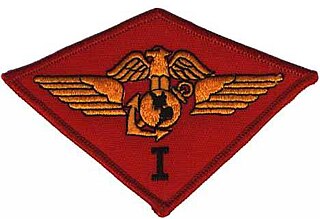
The 1st Marine Aircraft Wing is an aviation unit of the United States Marine Corps that serves as the Aviation Combat Element of the III Marine Expeditionary Force. The wing is headquartered at Camp Foster on the island of Okinawa, Japan. Activated in 1940, the wing has seen heavy combat operations during World War II, the Korean War, and the Vietnam War.
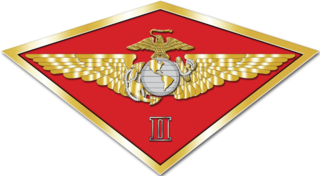
The 2nd Marine Aircraft Wing is the major east coast aviation unit of the United States Marine Corps and is headquartered in Marine Corps Air Station Cherry Point, North Carolina. The Wing provides the aviation combat element for the II Marine Expeditionary Force.
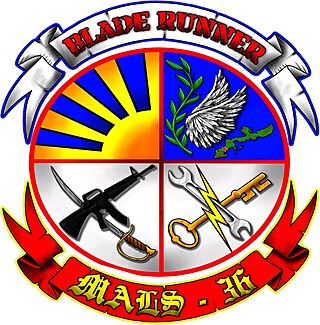
Marine Aviation Logistics Squadron 36 (MALS-36) is an aviation logistics support unit of the United States Marine Corps. Nicknamed Bladerunner, they are currently based at Marine Corps Air Station Futenma, Okinawa, Japan and fall under the command of Marine Aircraft Group 36 (MAG-36) and the 1st Marine Aircraft Wing.
In the United States Marine Corps, a Marine air–ground task force is the principal organization for all missions across the range of military operations. MAGTFs are a balanced air–ground, combined arms task organization of Marine Corps forces under a single commander that is structured to accomplish a specific mission. The MAGTF was formalized by the publishing of Marine Corps Order 3120.3 in December 1963, "The Marine Corps in the National Defense, MCDP 1-0". It stated:
A Marine air–ground task force with separate air ground headquarters is normally formed for combat operations and training exercises in which substantial combat forces of both Marine aviation and Marine ground units are included in the task organization of participating Marine forces.

Marine Aircraft Group 31 (MAG-31) is a United States Marine Corps aviation group based at Marine Corps Air Station Beaufort, South Carolina that is currently composed of two F/A-18C Hornet squadrons, one F/A-18A++ Hornet squadron, two F/A-18D Hornet squadrons, one F-35B Lightning II training squadron, one F-35C Lightning II squadron and an aviation logistics squadron. It falls under the command of the 2nd Marine Aircraft Wing.
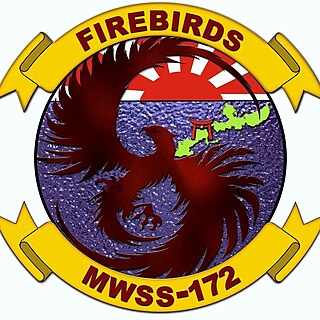
Marine Wing Support Squadron 172 is an aviation support unit of the United States Marine Corps's 1st Marine Aircraft Wing. Known as the "Firebirds", they are based out of Camp Foster, Okinawa, Japan. Previously part of Marine Wing Support Group 17 before they disbanded, MWSS-172 now falls under Marine Aircraft Group 36.

Marine Fighter Attack Squadron 312 (VMFA-312) is a United States Marine Corps F/A-18C Hornet squadron. Also known as the "Checkerboards", the squadron is based at Marine Corps Air Station Beaufort, South Carolina and falls under the command of Marine Aircraft Group 31 (MAG-31) and the 2nd Marine Aircraft Wing. The Radio Callsign is "Check."

Marine Fighter Attack Squadron 533 (VMFA-533) is a United States Marine Corps F-35B squadron. Also known as the "Hawks", the squadron is based at Marine Corps Air Station Beaufort, South Carolina and falls under the command of Marine Aircraft Group 31 (MAG-31) and the 2nd Marine Aircraft Wing.
Marine Aviation Logistics Squadron 31 (MALS-31) is an aviation logistics support unit of the United States Marine Corps. Known as the "Stingers", they fall under the command of Marine Aircraft Group 31 (MAG-31) and 2nd Marine Aircraft Wing and are currently based at Marine Corps Air Station Beaufort.

The United States Marine Corps is organized within the Department of the Navy, which is led by the Secretary of the Navy (SECNAV). The most senior Marine commissioned officer is the Commandant of the Marine Corps, responsible for organizing, recruiting, training, and equipping the Marine Corps so that it is ready for operation under the command of the unified combatant commanders. The Marine Corps is organized into four principal subdivisions: Headquarters Marine Corps, the Operating Forces, the Supporting Establishment, and the Marine Forces Reserve.
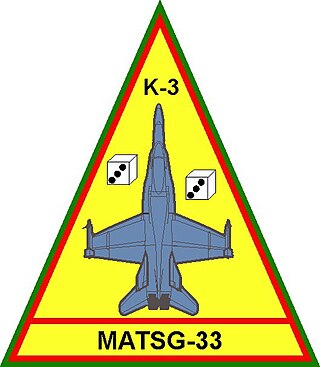
Marine Aviation and Training Support Group 33 (MATSG-33) is a United States Marine Corps aviation training group that was originally established during World War II as Marine Aircraft Group 33 (MAG-33). Fighter squadrons from MAG-33 fought most notably during the Battle of Okinawa and also as the first Marine aviation units to support the Korean War when they arrived as part of the 1st Provisional Marine Brigade. They helped stabilize the United Nations positions during the Battle of Pusan Perimeter and fought in Korea for the remainder of the war. At some point in the 1960s, the group was deactivated and was not reactivated until 2000, when Marine Aviation Training Support Group at Naval Air Station Oceana, Virginia was renamed MATSG-33.

The United States Taiwan Defense Command was a sub-unified command of the United States Armed Forces operating in Taiwan from December 1954 to April 1979.

Operation Tomodachi was a United States Armed Forces assistance operation to support Japan in disaster relief following the 2011 Tōhoku earthquake and tsunami. The operation took place from 12 March to 4 May 2011; involved 24,000 U.S. servicemembers, 189 aircraft, 24 naval ships; and cost $90 million.
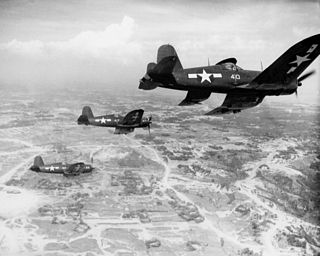
The Tactical Air Force, Tenth Army (TAF) was a joint aviation command of the Tenth United States Army that was responsible for commanding all land-based aviation and aviation command and control units during the Battle of Okinawa. The TAF's headquarters was provided by the 2nd Marine Aircraft Wing and it was the largest joint aviation unit under Marine Corps command during World War II. During the battle, the TAF was commanded by Major General Francis P. Mulcahy until ill-health forced him to be relieved by MajGen Louis E. Woods. According to United States sources, TAF aircraft were responsible for shooting down 637 Japanese aircraft during the battle.
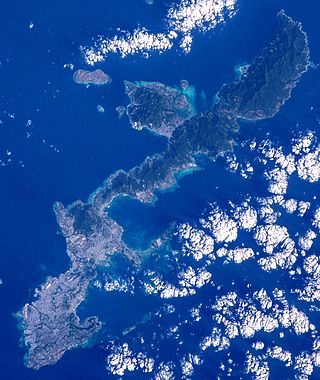
Naval Base Okinawa, now Naval Facility Okinawa, is a number of bases built after the Battle of Okinawa by United States Navy on Okinawa Island, Japan. The naval bases were built to support the landings on Okinawa on April 1, 1945, and the troops fighting on Okinawa. The Navy repaired and did expansion of the airfields on Okinawa. United States Navy Seabees built or repaired the facilities on the island. The bases on Okinawa put the United States Armed Forces only 350 miles from Japan's home islands. Most facilities closed after the war, but some are still in use today by all branches of the United States Armed Forces.



















